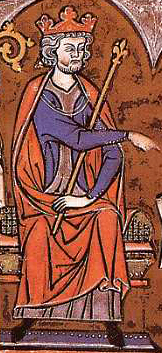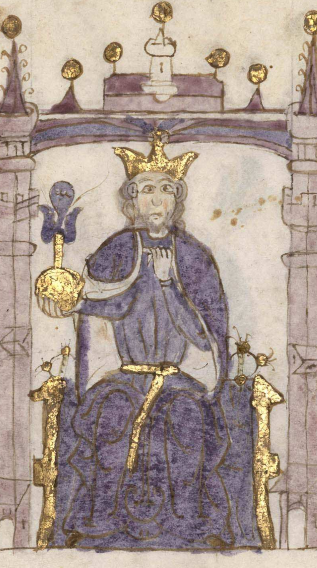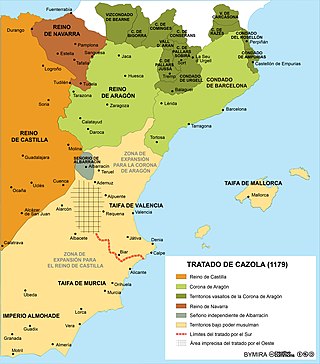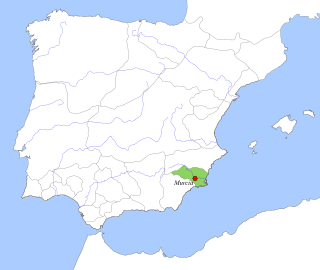Related Research Articles

The Reconquista is the historical term used to describe the military campaigns that Christian kingdoms waged against the Moors from the 8th century until 1492, in order to retake—or reconquer—the Iberian territories which were lost due to the Umayyad conquest of Hispania. The beginning of the Reconquista is traditionally dated to the Battle of Covadonga, in which an Asturian army achieved the first Christian victory over the forces of the Umayyad Caliphate since the beginning of the military invasion. Its culmination came in 1492 with the fall of the Nasrid kingdom of Granada to the united Spanish Crown of Ferdinand II of Aragon and Isabella I of Castile.

James I the Conqueror was King of Aragon and Lord of Montpellier from 1213 to 1276; King of Majorca from 1231 to 1276; and Valencia from 1238 to 1276 and Count of Barcelona. His long reign—the longest of any Iberian monarch—saw the expansion of the Crown of Aragon in three directions: Languedoc to the north, the Balearic Islands to the southeast, and Valencia to the south. By a treaty with Louis IX of France, he achieved the renunciation of any possible claim of French suzerainty over the County of Barcelona and the other Catalan counties, while he renounced northward expansion and taking back the once Catalan territories in Occitania and vassal counties loyal to the County of Barcelona, lands that were lost by his father Peter II of Aragon in the Battle of Muret during the Albigensian Crusade and annexed by the Kingdom of France, and then decided to turn south. His great part in the Reconquista was similar in Mediterranean Spain to that of his contemporary Ferdinand III of Castile in Andalusia. One of the main reasons for this formal renunciation of most of the once Catalan territories in Languedoc and Occitania and any expansion into them is the fact that he was raised by the Knights Templar crusaders, who had defeated his father fighting for the Pope alongside the French, so it was effectively forbidden for him to try to maintain the traditional influence of the Count of Barcelona that previously existed in Occitania and Languedoc.

Alfonso II, called the Chaste or the Troubadour, was the King of Aragon and, as Alfons I, the Count of Barcelona from 1164 until his death. The eldest son of Count Ramon Berenguer IV of Barcelona and Queen Petronilla of Aragon, he was the first King of Aragon who was also Count of Barcelona. He was also Count of Provence, which he conquered from Douce II, from 1166 until 1173, when he ceded it to his brother, Ramon Berenguer III. His reign has been characterised by nationalistic and nostalgic Catalan historians as l'engrandiment occitànic or "the Pyrenean unity": a great scheme to unite various lands on both sides of the Pyrenees under the rule of the House of Barcelona.

Philip III, called the Bold, was King of France from 1270 until his death in 1285. His father, Louis IX, died in Tunis during the Eighth Crusade. Philip, who was accompanying him, returned to France and was anointed king at Reims in 1271.

Ferdinand IV of Castile called the Summoned, was King of Castile and León from 1295 until his death.
Alfonso VIII, called the Noble or the one of Las Navas, was King of Castile from 1158 to his death and King of Toledo. After having suffered a great defeat with his own army at Alarcos against the Almohads in 1195, he led the coalition of Christian princes and foreign crusaders who broke the power of the Almohads in the Battle of Las Navas de Tolosa in 1212, an event which marked the arrival of a tide of Christian supremacy on the Iberian peninsula.

Denis, called the Farmer King and the Poet King, was King of Portugal. The eldest son of Afonso III of Portugal by his second wife, Beatrice of Castile, and grandson of Afonso II of Portugal, Denis succeeded his father in 1279. His marriage to Elizabeth of Aragon, who was later canonised as a saint of the Roman Catholic Church, was arranged in 1281 when she was 10 years old.

James II, called the Just, was the King of Aragon and Valencia and Count of Barcelona from 1291 to 1327. He was also the King of Sicily from 1285 to 1295 and the King of Majorca from 1291 to 1298. From 1297 he was nominally the King of Sardinia and Corsica, but he only acquired the island of Sardinia by conquest in 1324. His full title for the last three decades of his reign was "James, by the grace of God, king of Aragon, Valencia, Sardinia and Corsica, and count of Barcelona".

The Crown of Aragon was a composite monarchy ruled by one king, originated by the dynastic union of the Kingdom of Aragon and the County of Barcelona and ended as a consequence of the War of the Spanish Succession. At the height of its power in the 14th and 15th centuries, the Crown of Aragon was a thalassocracy controlling a large portion of present-day eastern Spain, parts of what is now southern France, and a Mediterranean empire which included the Balearic Islands, Sicily, Corsica, Sardinia, Malta, Southern Italy and parts of Greece.

Sancho Garcés VI, called the Wise was King of Navarre from 1150 until his death in 1194. He was the first monarch to officially drop the title of King of Pamplona in favour of King of Navarre, thus changing the designation of his kingdom. Sancho Garcés was responsible for bringing his kingdom into the political orbit of Europe. He was the eldest son of García Ramírez, the Restorer and Margaret of L'Aigle.

The Kingdom of Valencia, located in the eastern shore of the Iberian Peninsula, was one of the component realms of the Crown of Aragon. When the Crown of Aragon merged by dynastic union with the Crown of Castile to form the Kingdom of Spain, the Kingdom of Valencia became a component realm of the Spanish monarchy.

The House of Trastámara was a royal dynasty which first ruled in the Crown of Castile and then expanded to the Crown of Aragon in the late middle ages to the early modern period.

The War of the Sicilian Vespers, also shortened to the War of the Vespers, was a conflict waged by several medieval European kingdoms over control of Sicily from 1282 to 1302. The war, which started with the revolt of the Sicilian Vespers, was fought over competing dynastic claims to the throne of Sicily, and grew to involve the Kingdom of Aragon, the House of Anjou, France, and the papacy.

The Treaty of Cazola was signed in 1179 in Soria between Alfonso II of Aragon and Alfonso VIII of Castile. The pact divided Andalusia into separate zones of conquest for the two kingdoms, so that the work of the Reconquista would not be stymied by internecine feuding over spoils among the Christians. Aragon was given the places of Xàtiva, Denia, and Biar, from Biar to Calpe towards Valencia. Castile had all the lands on the other side of Biar. Compared with the earlier Treaty of Tudilén, Aragon had lost the right of annexing Murcia. The agreement further stipulated that it was to be held in perpetuity and upheld by the successors of both Alfonsos. This was reinforced with a clause stating that neither king could give up his part or diminish the part of the other, nor could any obstacle be put in the way by either king of the conquest by his counterpart of his rightful division. The subsequent breach of the treaty by both parties led to the Treaty of Almizra in 1244.

The Treaty of Almizra was the third of a series of three treaties between the Crown of Aragon and Crown of Castile meant to determine the limits of their expansion into Andalusia so as to prevent squabbling between the Christian princes. Specifically, it defined the borders of the Kingdom of Valencia. James I of Aragon signed it on 26 March 1244, but Alfonso X of Castile did not affirm it until much later. According to the treaty, all lands south of a line from Biar to Villajoyosa through Busot were reserved for Castile. This ended most further Aragonese expansion on the Iberian peninsula.
The Treaty of Torrellas, signed in Torrellas on 8 August 1304, settled the question of conquest of the Kingdom of Murcia, thitherto a dependency of the Crown of Castile, by James II of Aragon. The agreement favored the Crown of Aragon, straining ties.

The Taifa of Murcia was an Arab taifa of medieval Al-Andalus, in what is now southern Spain. It became independent as a taifa centered on the Moorish city of Murcia after the fall of the Umayyad Caliphate of Córdoba. The Moorish Taifa of Murcia included Albacete and part of Almería as well.

Aḥmad III Abū Jaʿfar ibn ʿAbd al-Malik al-Mustanṣir, called Sayf al-Dawla, Latinised as Zafadola, was the last ruler of the Hudid dynasty. He ruled the rump of the taifa kingdom of Zaragoza from his castle at Rueda de Jalón, in what is now Spain. He was the son of Abd al-Malik.

The Mudéjar revolt of 1264–1266 was a rebellion by the Muslim populations (Mudéjares) in the Lower Andalusia and Murcia regions of the Crown of Castile. The rebellion was in response to Castile's policy of relocating Muslim populations from these regions and was partially instigated by Muhammad I of Granada. The rebels were aided by the independent Emirate of Granada, while the Castilians were allied with Aragon. Early in the uprising, the rebels managed to capture Murcia and Jerez, as well as several smaller towns, but were eventually defeated by the royal forces. Subsequently, Castile expelled the Muslim populations of the reconquered territories and encouraged Christians from elsewhere to settle their lands. Granada became a vassal of Castile and paid an annual tribute.

The documented history of Murcia traces back at least to the Middle Ages, after Madinat Mursiya was built by Andalusi Emir Abd al-Rahman II in the 9th century, while it is suggested the city was erected over a previous settlement of Roman origin.
References
- ↑ Such, Peter (2020-05-28). Chronicle of King Pedro Volumes 1 - 3: Pero López de Ayala. Oxford University Press. p. 358. ISBN 978-1-78962-134-1.
- ↑ Reuter, Timothy (1995). The New Cambridge Medieval History: Volume 6, C.1300-c.1415. Cambridge University Press. p. 625. ISBN 978-0-521-36290-0.
- ↑ Kinkade, Richard P. (2004). "Beatrice "Contesson" of Savoy (c. 1250-1290): The Mother of Juan Manuel". La corónica: A Journal of Medieval Hispanic Languages, Literatures, and Cultures. 32 (3): 163–225. doi:10.1353/cor.2004.0017. ISSN 1947-4261. S2CID 163041548.